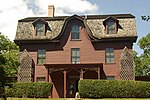Willow Dell

Willow Dell, also known as the Weeden Farm, is a historic farmhouse in South Kingstown, Rhode Island. It is located on the south side of the highway, just west of Matunuck Beach Road, on a 7-acre (2.8 ha) parcel of land. The main block of the 2+1⁄2-story gambrel-roofed house was built c. 1752 by Colonel Jeremiah Bowen, and was purchased in 1826 by Wager Weeden, whose descendants still own the property. The property includes two barns, a garage, and a stable which has been converted to residential use, as well as the Wager Weeden Memorial Fountain, visible on the south side of the highway by a stone marker.The house was listed on the National Register of Historic Places in 1996.
Excerpt from the Wikipedia article Willow Dell (License: CC BY-SA 3.0, Authors, Images).Willow Dell
Commodore Perry Highway,
Geographical coordinates (GPS) Address Website Nearby Places Show on map
Geographical coordinates (GPS)
| Latitude | Longitude |
|---|---|
| N 41.396388888889 ° | E -71.551111111111 ° |
Address
The Barn
Commodore Perry Highway
02879
Rhode Island, United States
Open on Google Maps







